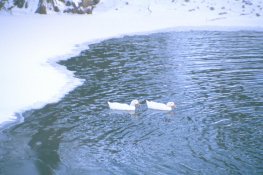THE PROBLEM IS WITH THE CASSETTES RATHER THAN WITH THE FILM
On 5 August I posted some batch numbers (well, emulsion numbers) and how yellow the film from them was, in post 151 of this thread.
I quote part of that below. I apologise, the second emulsion number should have been given as 67821602.
Like others here, I decided to try the Wittner film and compare it with the film sold by Maco. To avoid any effects from light-piping, I put the unopened film packages and camera bodies in a changing bag and so loaded each film in complete darkness. Just to compare, I also loaded a roll of Wittner film into a camera in subdued light.
The Wittner film gave very nice results. Not the same palette as Fujichrome, nor Ektachrome: well, as it should, it looked more like Agfachrome! No yellow cast at all.
What amazed me was that the Rollei CR 200 (emulsion 67821602) and the Crossibird (67821607) were nearly identical to it. No yellow cast at all on the Crossbird. Maybe a very slight yellow cast on the Rollei, possibly due to the film having been packaged some years earlier.
If just one roll had been unfogged, I would have thought maybe I was lucky with that one. But two, from different batches, both without a marked yellow fog when loaded in the dark, lead me to conclude that the yellow fog is due to light piping in cassettes that do not have the light trapping felt tightly closed, or have poor quality felt. This was one suggestion I made in my previous post.
The Wittner film loaded into a camera in subdued light showed absolutely no yellow fog either. Better felt, or a tighter closure of the cassette, I assume.
I now think that the problem is that the machine closing the 35mm cassettes into which Maco was loading cut-down Aviphot was, for a time, not closing tightly enough at the felt light trap. Even under subdued light some light could enter along the film leader poking out, and was piped down the film for a long way.
Rather than throw away any remaining rolls of Rollei Digibase 200, of Rollei Crossbird 200 and of Lomography XPro 200, it is best to keep the films in their original packaging and to load them into your camera in complete darkness. When the film is finished, wind it completely back into the cassette, so there is no leader left out of the cassette, then put the cassette in a black film holder, not a transparent one, until it is processed.
This problem will not affect 120 film, since there is no film leader. Unfortunately, no 120 Digibase CR 200 film is available from Maco just now, but apparently more will be available soon.
Many thanks to everyone, a summary of my earlier post follows.
If it helps, here are some batch numbers and what I found with them.
67821601, sold as Rollei Digibase 200. Very strongly yellow at the beginning of the roll, still yellow at the end.
67821602, sold as Rollei Digibase 200. Noticeably yellow at the beginning, very mildly yellow at all at the end.
67821606, sold as Lomography XPro 200. Markedly yellow at the beginning, slightly yellow at the end.
67821607, sold as Rollei Crossbird. Markedly yellow at the beginning, very mildly yellow at the end.
A few more comments:
The film is definitely not planned to be yellow to correct for the blue tint possibly produced in aerial photography.
The yellow is nothing to do with poor processing.
The yellow cast is not due to bad storage of master rolls, as it varies from strong at the beginning of 35mm rolls, to less at the end of rolls. It could to be due to:
Bad practice in spooling individual rolls of 35mm film, leading to some, or a lot, of light piping down the roll.
Poor quality light trapping felt on the 35 mm film canisters. THIS, OR THE CASSETTE NOT CLOSED TIGHTLY, IS WHAT THE ABOVE REPORT SUGGESTS.
Storage in very bad conditions, leading to the film on the outside of the film canister getting a strong yellow fog, the film near the center of the canister being less affected.

















